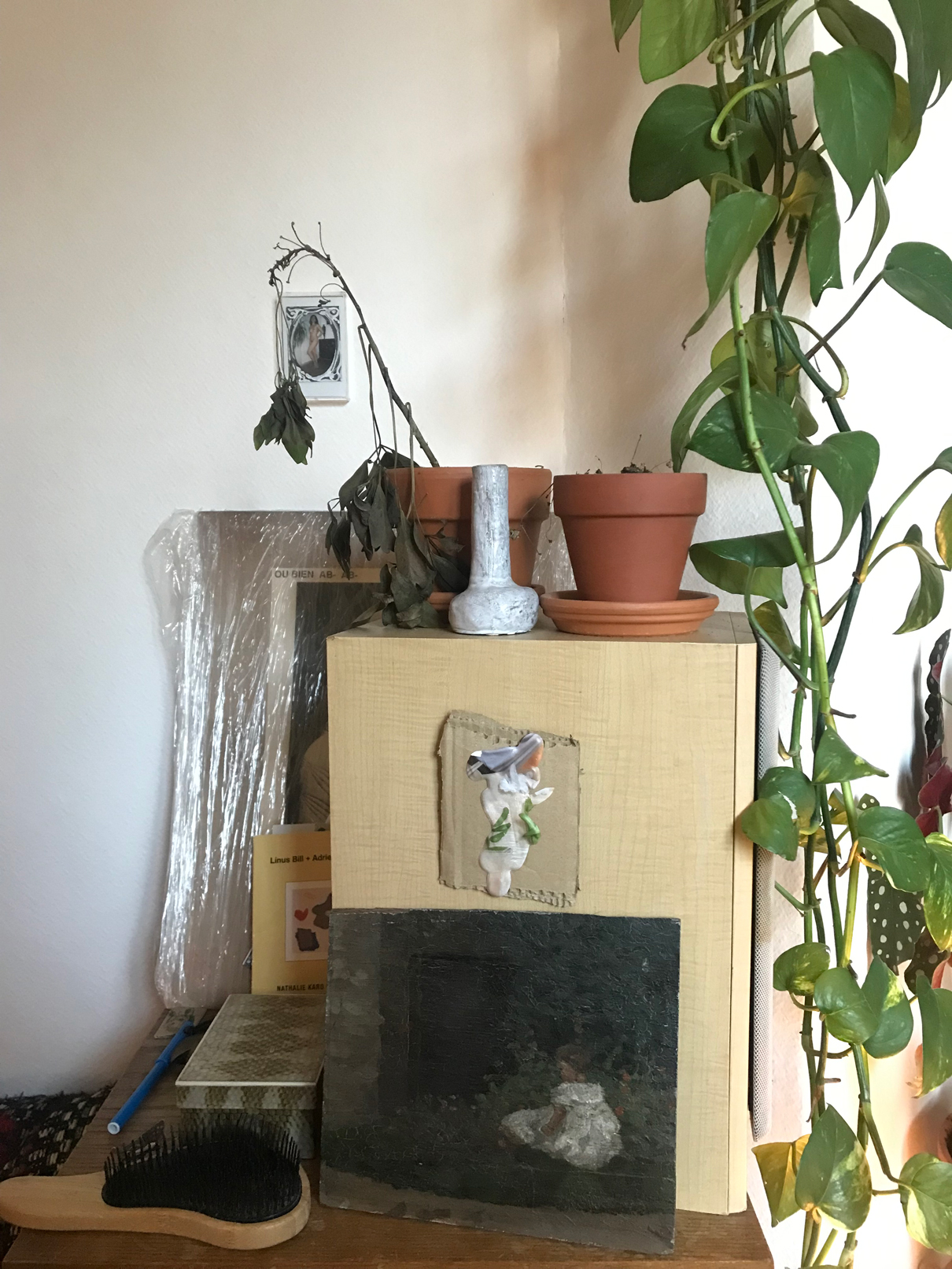Julien Carreyn: a malicious pleasure to watch from afar
A reflection on the art of Julien Carreyn, whose small-scale paintings and photographs seduce you to come close, very close even
Arranged on small shelves, combined in display cases, or aligned on the wall as a series, Julien Carreyn’s photos, drawings and paintings constitute an intimate universe of desire and memory. The staging of his works, often of very small format, is inspired by the idea of a film synopsis, or even more, by the flatplan of a book. In the publishing industry, for which Carreyn was initially trained, the flatplan is the global representation on the same plane of the reduced pages of a book, page by page. Combined in this way, the images of models, interiors, street corners, or more abstract visions, activate a narrative whose story is not really revealed. Only the feeling of Sehnsucht circumscribes a novelistic perimeter. In French as well as in English, the word Sehnsucht does not really have an equivalent. From its root—Sehn (to see) and Sucht (desire)—it could be describing the desire to see something away with a distant eye, which is one of the properties of the camera. Like a voyeur sublimating from afar what he looks at, occasionally suggesting an underlying eroticism, Carreyn’s Sehnsucht weaves multiple readings together, shaping them through the works’ techniques, sizes, and subjects. From what distance—both in time and space— does desire arise? It is from this question that Carreyn’s artistic universe seems to unfold.





Small in size, sometimes even miniature, Carreyn’s paintings and photographs demand to be seen up close, very close even. Apart from a few large and medium formats, his works are never bigger than 20 cm in height or width: the standard 8,8 x 10,7 cm of his Polaroid pictures; the 7,5 x 5 cm of his smallest paintings from the recent series Les pharmacies du Sacré-Cœur XXX (2022). Only a close physical proximity allows a proper view of these photographs, paintings and drawings, which seem to force us towards them to reveal themselves and penetrate the intimacy of what they represent.

It is no coincidence that the nude is one of Carreyn’s favorite subjects in his photographs. Whether in a private environment, a living room, a bedroom, or a more incongruous place such as a furniture exhibition space (Muirta (2019)), or at the edge of a forest (Untitled (2020)), his models convey a certain feeling of everydayness. The simplicity of the artist’s photographic protocol—the polaroid’s lack of zoom, which makes the distance between photographer and model tangible—carries with it an intimate and familiar atmosphere. The natural nudity and the stripping of technical effects express proximity and the delicate eroticism also found in Eric Rohmer’s films or Francesca Woodman’s photographs. In fact, nudity bears no relation to the sensuality in Carreyn’s work.


Recently presented by Galerie Crèvecoeur at CFAlive in Milan, Carreyn’s latest series of black and white silver prints Pontoise (2022) and Les Pavillons-sous-Bois (2022) testify to this. Depicting interiors of municipal libraries plunged into a soft, almost subdued and homogeneous light, the photographs reveal these spaces as some of desire. The empty aisles seem to contain a floating moment reminiscent of how Luigi Ghirri transcribed the sensation of air, space, colors, and materials of his architectural subjects. In this peaceful atmosphere, it is precisely the absence of any human figure that opens a breach to the projection of desire, as if it were possible to slip unseen through the rows of these quiet places.

Yet, even with physical proximity and despite their simplicity, these images seem to contain an immutable distance. Whether Polaroid, Intax (another kind of Polaroid), thermal or laser prints, Carreyn’s works have a specific tone and a muted grain. Unlike high quality cameras and films that render colors in all their intensity, the artist’s medium of choice makes for an ordinary timbre, characteristic of everyday use. The film itself generates pastel and washed-out tones as if a veil were covering its surface. This palette takes the works to a different time, one that is resolved and blurred as memories are—what is given to us to see moves away from us again.
The same could be said about Carreyn’s paintings from Les Pharmacies du Sacré-Cœur XXX series. Installed on a small white three-tiered shelf, they mix abstraction and figuration. Sometimes only two brush strokes are enough to cover their surface. Other times, they sketch a landscape or an interior. They all take up the pink and blue tones of Matisse’s paintings, which the artist has consciously appropriated as a kind of homage. These small paintings, which one would hardly dare to hold so much their size makes them precious and fragile, testify to a fascination for painting as a way to suggest unreachability and dispossession. Ultimately, these shelves represent the fantasy of a collection that is forever inaccessible.

Impregnated with calm, immersed in a soft light, or even covered by a veil, Carreyn’s art invariably establishes a distance between the viewer’s eye and the subject. This distance is physical and temporal at once—the work’s small size coexists with subjects that seem to emerge from a memory. It is nevertheless neither cold nor rejecting. On the contrary, it hinges on desire, as it draws us close, but also, through its texture, it translates the fragility of a moment. Its evanescence makes you want to be physically captured. Just when time and space slip away from any form of possession, the work itself becomes the means of possessing what one sees. Thus, through the desire to see something distant, the Sehnsucht, the possibility of touching the unattainable with one’s eyes becomes the object of pleasure.
April 19, 2022
